Have you ever wondered: How do I travel long distances with a cat? Is it a wild dream or a real possibility? Cat owners everywhere ponder this curious question as they plan cross-country moves or long-awaited vacations. If the thought of a road trip with your feline companion fills you with both excitement and a little anxiety, you’re in the right place! This guide will demystify cat car travel, bust some myths, and show you how a long distance journey with your cat can be not only stress-free but rewarding for both of you.
Curious About Taking Your Cat on a Long Distance Road Trip? Your Guide to Stress-Free Cat Car Travel
"Is taking your cat on a cross-country journey merely wishful thinking or a real possibility? Let's explore the reality behind how you can actually make long distance travel a comfortable adventure for your feline companion."
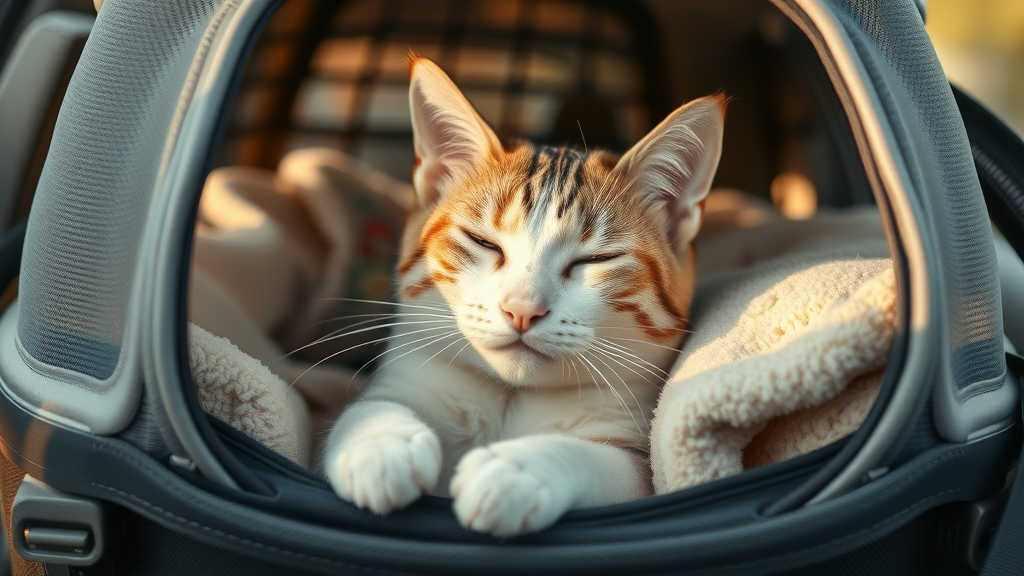
Planning a long distance road trip with your cat may seem like a daunting task at first. However, with a thoughtful approach to cat car travel and a few easy-to-follow steps, you and your furry friend can enjoy the open road together. Whether you’re relocating across states, visiting family several hours away, or setting out on an epic adventure, making your cat an integral part of the experience is absolutely possible. By understanding your cat's specific needs and planning ahead, you can reduce stress, ensure safety, and even make the journey enjoyable for both of you. In the sections ahead, we'll cover everything from choosing the best cat carrier and managing road trip rest stops to top techniques for keeping your cat calm and comfortable during those milestone miles.
Why Safe and Happy Cat Car Travel Matters on Road Trips
Understanding Your Cat’s Needs and Fears During Long Distance Drives
Cats are creatures of habit, drawn to the familiar routines and safe spaces of home. When you introduce your cat to a long distance road trip , their world suddenly changes: sounds, smells, and the constant movement of a car ride can feel overwhelming. Recognizing why your cat may feel anxious is key to planning a smooth car trip. Cats often interpret new environments—especially confined ones like a cat carrier on the back seat—as potential threats. It's important for cat parents to be patient, empathetic, and to introduce travel elements, like the carrier or crate, slowly and positively before departure.
Comfort is essential. Consider what makes your cat feel at home: a cozy cat bed, soothing scents, or a favorite toy. Ensuring these comforts are accessible during your journey can help your cat adapt to sudden disruptions in routine. Additionally, empowering your cat to feel secure in their safe space (the carrier or crate) will go a long way in reducing travel-related fears and allowing both of you to enjoy the journey.
Recognizing Signs of Cat Stress on the Road
Travel stress in cats can manifest in subtle and not-so-subtle ways. Some cats might vocalize loudly, pant, or drool; others may retreat into the back of the cat carrier and remain silent, refusing food or water. Other signs of stress include wide eyes, crouched posture, or excessive grooming. If you notice these behaviors during your long distance car trip, your cat may be overwhelmed. Recognizing them early allows you to make adjustments—like reducing noise, using soothing aids, or giving your cat extra privacy in their carrier or crate.
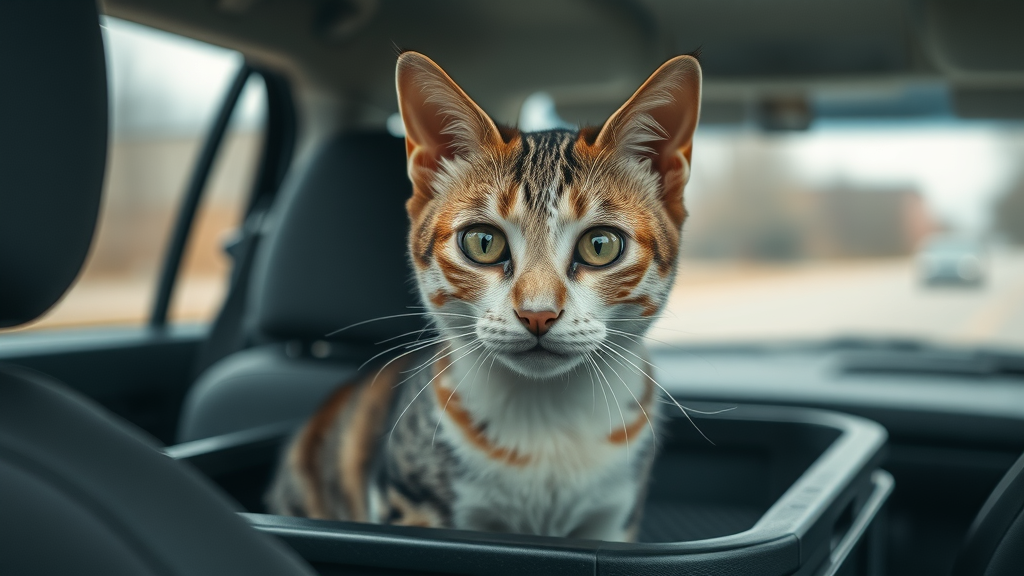
Monitoring your cat's body language throughout the trip helps you determine whether they need a break at a rest stop, some extra reassurance, or simply some time to acclimate. By staying attentive and responsive, you can transform potential stress into manageable, positive experiences for both you and your feline travel companion.
Planning a Successful Long Distance Road Trip with Your Cat
Choosing the Best Cat Carrier for Travel: Safety and Comfort
Selecting a secure, comfortable cat carrier is one of the most important steps before any road trip with your furry friend. The carrier should be large enough for your cat to stand up, turn around, and lie down comfortably, while also being sturdy enough to protect them during a sudden stop. Look for models with good ventilation , a padded bottom (add a soft cat bed or blanket), and a front-loading, secure door. Soft-sided carriers may be more comfortable for some cats, while hard-sided carriers might feel more like a safe space, especially on longer car rides.
Make sure the carrier can be secured safely in the car—ideally in the back seat using the seatbelt. Test out the carrier at home: encourage your cat to use it as a cozy retreat by placing treats, their favorite toy, or a small blanket inside. Gradually increase the carrier time so your cat feels at home and less nervous on the big day. Remember, your cat’s safe space during the journey is also your peace of mind as a cat parent.
Preparing Your Car for a Cat-Friendly Road Trip
Transforming your vehicle into a cat-safe zone will go a long way toward ensuring a comfortable road trip. Before departure, check that your car’s interior is free from items that could fall or shift during travel—including bulky luggage or loose objects. Use sunshades or curtains as needed to minimize glare and prevent the car from overheating. You may want to line the back seat with a waterproof mat or towels for extra comfort, especially if your cat is new to long journeys. For extra peace of mind, consider using a privacy screen, which can help block distracting views and allow your cat to feel safe in their carrier or crate.
Double-check windows and doors are closed or locked to prevent accidental escapes if you need to open the door during stops.
Secure your cat carrier using the seatbelt or special straps to keep it from shifting in case you need to brake suddenly.
Adjust the car’s temperature (not too hot or cold) and circulate air gently, being mindful not to direct strong drafts onto your cat.
Checklist: Essential Cat Car Travel Items:
Sturdy cat carrier
Travel litter box & travel litter
Portable cat bed or soft blanket
Calming treats, pheromone sprays, or calming collar
Food and water bowls (spill-proof if possible)
Bottled water & measured cat food portions
ID tag (collar and microchipped)
Favorite toy or comfort item
Pet health/vaccine records & emergency contacts
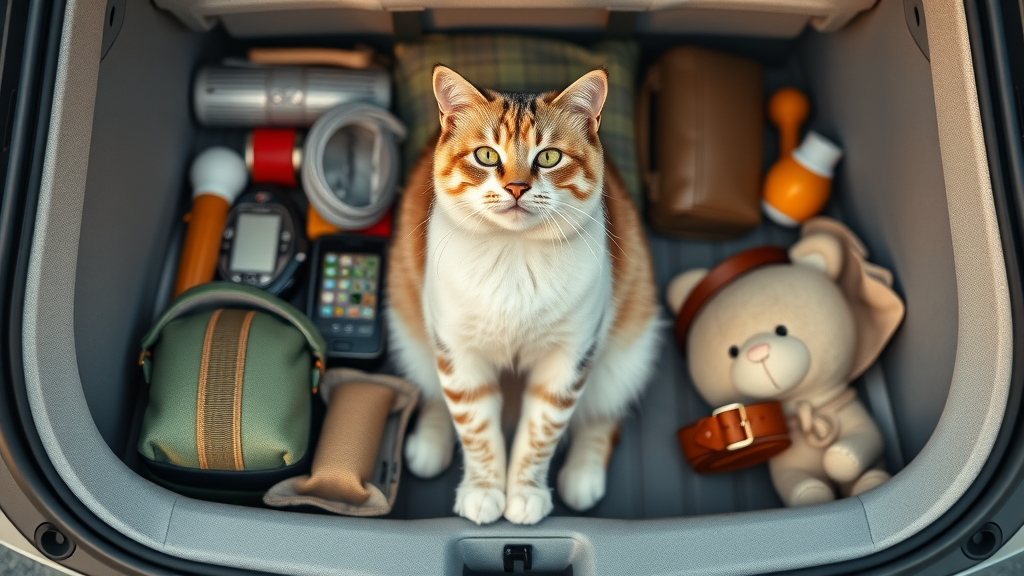
Scheduling Rest Stops for Litter Box Breaks and Hydration
Planning ahead for rest stops is vital to meet your cat’s basic needs during a long car trip. Unlike dogs, cats usually won’t walk outside for bathroom breaks, so a portable travel litter box is a must-have. Aim to stop every 2-4 hours on long distance road trips to offer your cat a quiet moment to use the litter box, get a drink of water, and stretch inside the carrier. Choose rest stops that are quieter and less populated if possible, as noise and commotion can cause extra stress.
Always keep your cat securely in the carrier or crate when the car doors are open—curiosity can quickly lead to a scared cat bolting out. Never leave your cat unattended in the parked car, even for a few minutes, as temperatures can fluctuate dangerously. Consistency with rest breaks also allows your cat to establish a small routine, making the road trip feel more predictable and less intimidating.
How Do I Travel Long Distances with a Cat? Step-by-Step Strategies
Gradually Introducing Your Cat to Car Rides Before Your Long Distance Road Trip
The success of traveling long distances with a cat often starts weeks in advance. Begin by letting your cat explore the car while it’s parked, with doors open for airflow and supervision. Place their cat carrier or crate in the back seat and encourage your cat to investigate, using treats or their favorite toy as incentive. Once your cat is comfortable inside the carrier, try short drives around your neighborhood, gradually increasing the distance over several sessions.
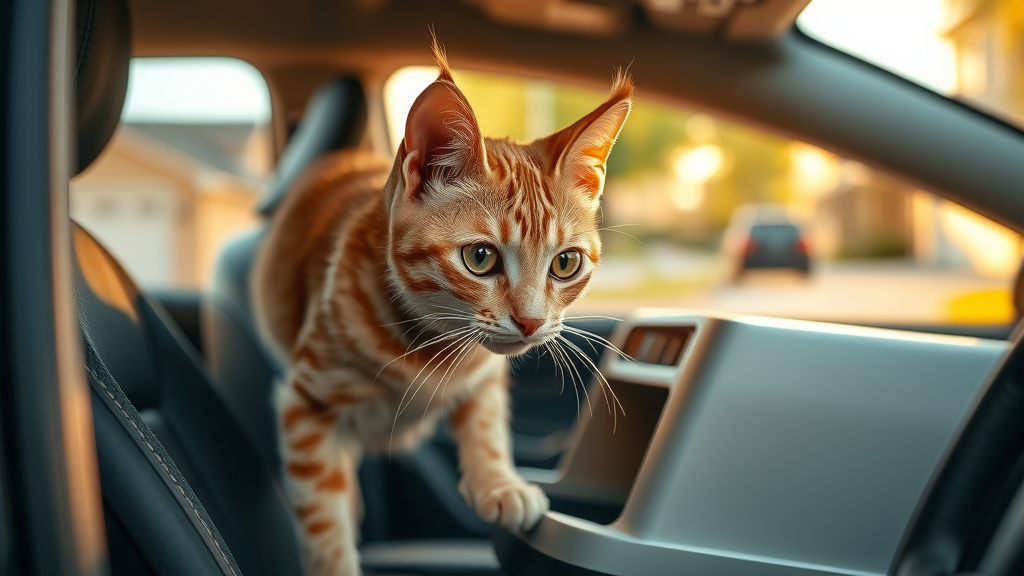
These training efforts help your cat adjust to the unique sounds, smells, and motion of car rides. Each positive experience builds their confidence and eases future anxiety. If your cat is especially fearful, consider using pheromone sprays or calming collars during these practice trips. With time, most cats learn that car rides—even long ones—can be a gateway to safe adventures, not just veterinarian visits!
Setting Up a Safe Space: Making the Cat Carrier Feel Like Home
The cat carrier should serve as a secure sanctuary, not a place of fear. Preparing it in advance is a good idea for both safety and comfort. Clean the carrier thoroughly, add a soft cat bed or favorite blanket, and include a scented item from home (like a t-shirt you’ve recently worn). Place a favorite toy inside for company, and consider using a catnip-infused mat or a pheromone-treated towel to enhance relaxation.
During the road trip, always position the carrier so your cat can see you and hear your reassuring voice. This safe space not only helps with stress but also provides a controlled environment should you need to open the car door for a rest stop or emergency. The more the carrier feels like part of your cat's daily life, the less likely they are to panic or resist longer car rides.
Maintaining Home Comforts: Familiar Items and Soothing Scents for Cats
One easy way to help your cat feel at home on the road is by surrounding them with familiar comforts. Bring along your cat’s preferred blanket, beds, and even their old food bowl or water dish if possible. The smells of home have a calming effect and signal safety—the ultimate goal during a long distance car trip.
Don't overlook the power of soothing scents. Synthetic feline pheromones, available as sprays or diffusers, can be applied to carriers or bedding before and during your journey. These mimic natural scents that help cats feel secure, especially useful for sensitive or anxiety-prone pets. Keep your cat's travel area clean, cozy, and filled with reminders of their favorite places.
Cat Litter Box Management for Long Distance Road Trips
Selecting the Right Travel Litter Box and Travel Litter
A travel litter box is an absolute must for any cat car journey. Choose a box that is lightweight, portable, and easy to clean. Some models fold for storage, while others have sturdy sides to prevent messes during bumpy road trips. Pair the box with a familiar travel litter to avoid introducing new smells or textures that could deter your cat from using it.
Consider carrying disposable litter boxes for longer car trips, which can be thrown away at rest stops for convenience, or line a reusable box with a disposable liner for easy cleaning. The goal is to maintain cleanliness and ensure your cat always has access when needed.
Litter Box Tips for Reducing Cat Stress in Car Travel
During a long distance journey, keep the litter box within easy reach—without opening the carrier in unsafe environments. Offer your cat access to the box at each rest stop and monitor their eliminations for signs of nervousness or health issues. Choose dust-free, unscented litter, as strong smells can bother cats on car rides.
Using a familiar travel litter box setup helps minimize disruptions to your cat's established bathroom routine, reducing the chances of accidents or stress behaviors in the car. Cleaning up promptly after use also prevents lingering odors and makes the back seat or car interior more pleasant for both of you.
Comparison of Popular Cat Carriers and Travel Litter Boxes |
||||
Product |
Features |
Portability |
Comfort |
Price |
|---|---|---|---|---|
Soft-sided Cat Carrier |
Lightweight, padded, mesh windows |
High |
Very comfortable |
$$ |
Hard-sided Cat Carrier |
Rigid shell, high safety, top opening door |
Medium |
Comfortable |
$$$ |
Collapsible Litter Box |
Folds flat, waterproof lining |
High |
Comfortable for most cats |
$ |
Disposable Litter Box |
Single use, biodegradable |
Very high |
Moderate comfort |
$ |
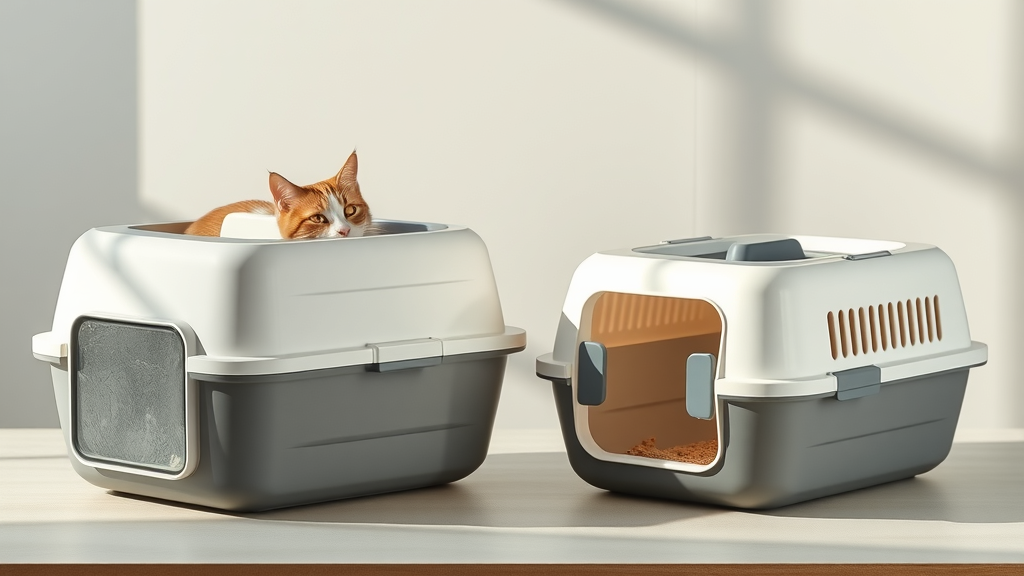
Keeping Your Cat Calm and Safe During Long Distance Cat Car Travel
Safe Space Techniques: Positioning and Securing the Cat Carrier in Your Car
The safest place for your cat on a road trip is secured in a carrier or crate—never loose in the car. Choose the back seat for the carrier and secure it with a seatbelt using the designated straps or harnesses. This prevents the carrier from sliding or tipping over if you brake suddenly. Facing the door towards you allows your cat to see you and hear reassuring words during the drive.

Never place the carrier in the front seat with an active airbag, as this can be dangerous. Creating a safe space with a familiar blanket or cat bed inside the carrier gives your cat comfort and reduces stress, turning the back seat into an oasis amidst the hustle of road travel.
Calming Aids for Cats: Pheromone Sprays, Calming Collars, and Natural Remedies
For especially anxious cats, various calming aids are available. Synthetic pheromone sprays mimic the natural signals cats use to mark safe spaces, helping them feel relaxed in unfamiliar environments. Calming collars, worn like an ID tag, release these pheromones continuously and are often a great idea for nervous travelers.
"Even cats that dislike brief car rides can adapt to long distance road trips with early, positive experiences and the right gear." – Dr. Rebecca T., Feline Behavior Specialist
Natural remedies such as herbal supplements (like chamomile or valerian for cats) may also help, but always consult with your veterinarian before using any medication or supplement on your trip. Products designed to calm, rather than sedate, are best for maintaining your cat’s alertness and comfort during transit.
Nutrition, Hydration, and Ventilation on a Cat Road Trip
Managing Food and Water Intake Before and During Travel
Feeding your cat a light meal a few hours before departure and offering water regularly can minimize the risk of nausea or motion sickness during the trip. Avoid feeding right before or during car rides unless necessary for longer journeys. Always provide fresh water at every rest stop using a spill-proof bowl, and monitor your cat’s hydration—it’s essential for their health, especially on warm travel days.
Pack enough of your cat’s regular food for the road trip and a couple of extra servings in case of delays. Keeping a consistent diet (using familiar food and water bowls) will help avoid digestive upsets and provide a small sense of normalcy on the journey.
Ensuring Proper Ventilation and Climate Control for Your Cat’s Safety
Good ventilation is critical for keeping your cat comfortable on a long distance road trip. Always crack windows for fresh air (without exposing your cat directly to the drafts) and use the car’s ventilation system to maintain a consistent, moderate temperature. Avoid leaving your car parked (even in cool weather) with your cat inside unattended—temperatures can rise rapidly, posing a risk of heatstroke.
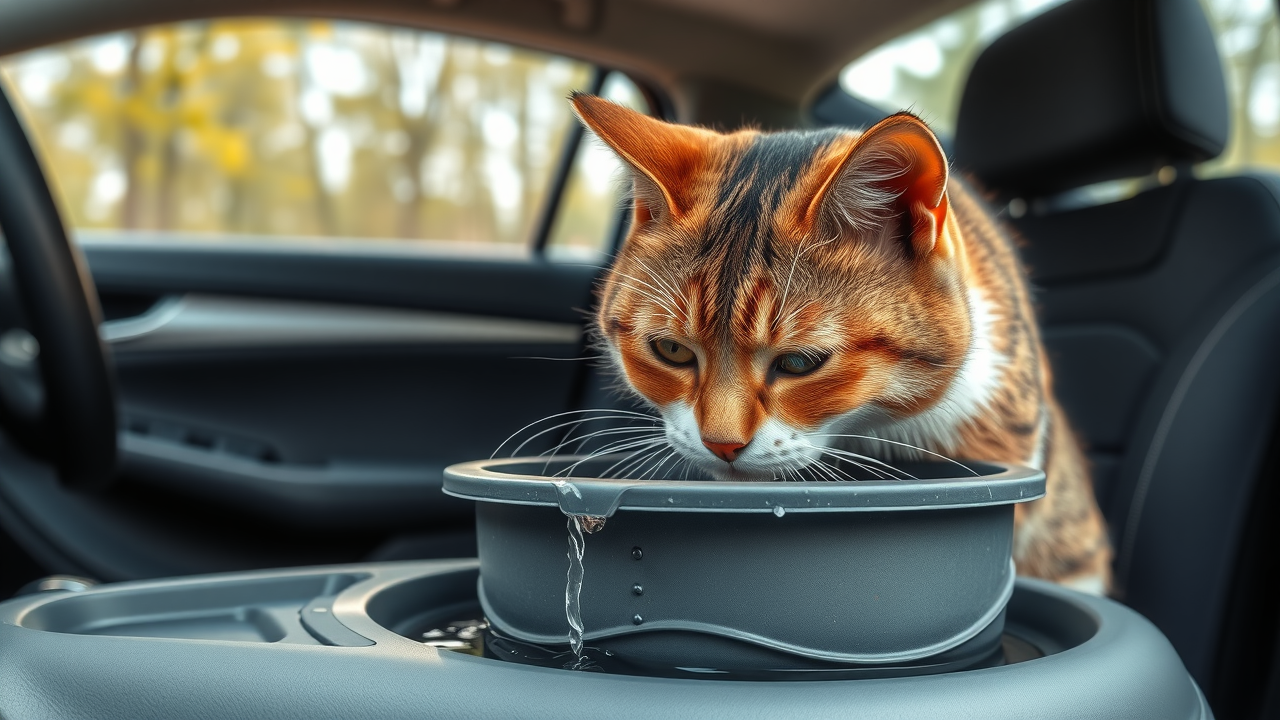
Consider a battery-powered fan for extra airflow on warm days. Regularly check your cat’s carrier for overheating and move it away from direct sunlight as the sun’s position changes on the road. Comfort and safety go hand in hand for a smoother journey.
Top Long Distance Cat Travel Tips Recap:
Introduce car rides gradually before the big road trip.
Use a sturdy, well-ventilated cat carrier as your cat’s safe space.
Pack all essentials: travel litter box, litter, food, water, calming aids, and an ID tag.
Plan consistent rest stops for litter box access and hydration.
Keep familiar comforts and scents in the carrier.
Stay alert for signs of stress; adjust as needed to keep your cat relaxed.
Never leave your cat alone in a parked car.
Use spill-proof food and water bowls to minimize mess.
Behind The Scenes: Setting Up For a Safe Cat Car Journey
In this behind-the-scenes feature, you’ll see the step-by-step preparations of a real cat parent loading up their car, checking their travel checklist, introducing their cat to the carrier, and demonstrating how to conduct safe and calm rest stops during a long distance journey. Video highlights include tips on identifying cat stress signals, using rest stops wisely for litter breaks, and the importance of patience with your feline companion. By following these expert routines, even first-time travelers can confidently embark on road trips with peace of mind.
People Also Ask: How to travel with cats long distance?
What’s the best way to prepare your cat and car for long distance travel?
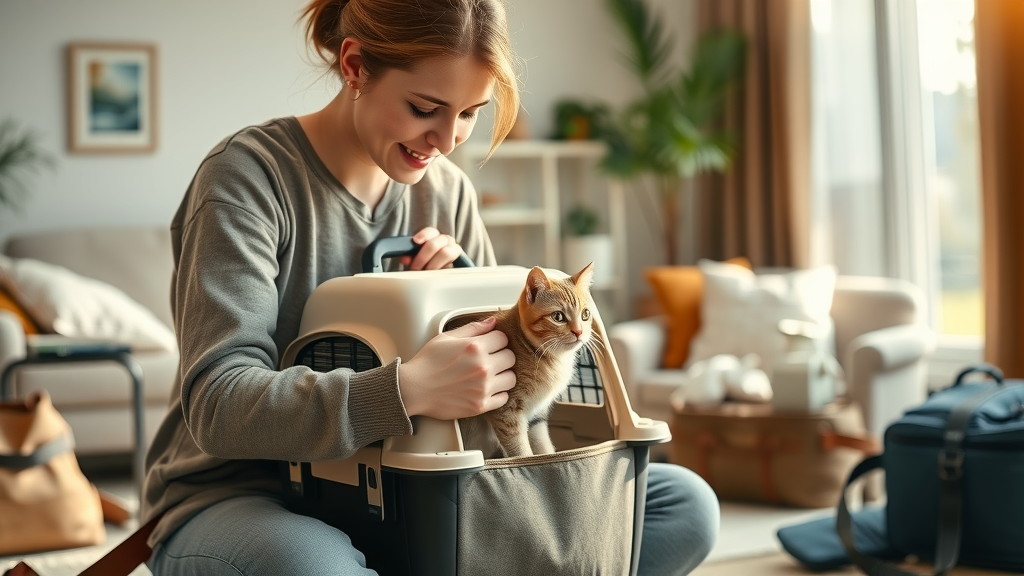
The best preparation begins by familiarizing your cat with their carrier and with short car trips weeks before your long journey. Pack all travel essentials—including a litter box, food, water, comfort items, and ID tags—and ensure your car is ready: secure loose objects, maintain stable temperatures, and schedule frequent rest stops. Creating a calm routine and rehearsing the travel environment can transform car rides from a source of stress to an adventure for both you and your cat.
How do you travel 10 hours in a car with a cat?
Traveling for 10 hours with a cat requires planning rest stops every 2-4 hours for litter box access, water, and a quiet break. Keep your cat in a comfortable, well-secured carrier, and provide familiar bedding and toys. Stay attentive to stress signs—such as meowing, hiding, or refusal to eat—and use calming aids if needed. Most importantly, never let your cat roam loose in the car, and never leave your pet alone in a parked vehicle, even for short periods.
Can cats handle extended car trips or will they be too stressed?
Many cats adapt well to long distance car trips if introduced gradually and provided with a comfortable, familiar environment. Preparing in advance with a safe carrier, home scents, consistent routines, and regular breaks can greatly reduce travel stress. For highly anxious cats, consult your vet about calming products or strategies. With patience and care, road trips with your cat can become both manageable and mutually enjoyable experiences.
Are Long Car Rides Stressful for Cats? Stress Signs and Solutions
Expert Tips to Recognize and Ease Cat Anxiety on Road Trips

Expert advice stresses the importance of vigilance for signs of anxiety: excessive vocalization, panting, hiding, or not using the litter box. To ease this stress, maintain a calm environment, offer reassurance, and stick to routines with food, water, and rest stops. Simple strategies, such as keeping the carrier covered during noisy parts of the journey or using pheromone sprays, provide an extra sense of security. Always consult a feline behavior specialist or veterinarian if you’re unsure about your cat’s travel readiness.
Is There a Time Limit for How Long a Cat Can Travel in a Car?
Understanding Safe Travel Lengths and Rest Stop Planning
While cats can often handle car rides of 8-12 hours with proper planning, it’s crucial to break up longer journeys with frequent rest stops. Plan for a minimum 15-20 minute break every 2-4 hours to allow your cat access to their litter box, water dish, and time to decompress. If your trip will last two days or more, arrange pet-friendly hotel stops where your cat can safely stretch, eat, and use the litter box without rushing, which is especially important on extended road trips.
Travel Duration Guidelines with Suggested Rest Breaks for Cats |
||
Travel Duration |
Minimum Break Frequency |
Suggested Activities |
|---|---|---|
2-4 hours |
1 break |
Hydration, check litter box, calm reassurance |
4-8 hours |
2-3 breaks |
Litter box use, food/water, stretch |
8+ hours |
3-4 breaks |
All activities above, longer rest for decompression |
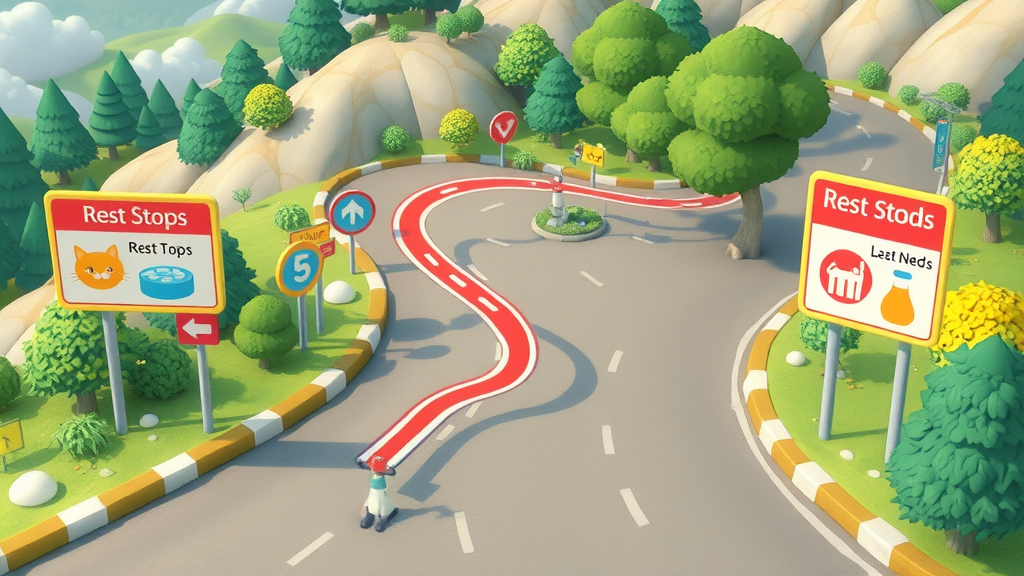
Preparing for Unexpected Issues: Cat Health and Emergency Preparedness on Long Distance Road Trips
Pack a Cat First Aid Kit and Emergency Contacts
Being prepared helps you stay calm in case of unexpected problems. Pack a cat-specific first aid kit with wound ointment, sterile gauze, medications, and a copy of your cat’s health and vaccine records. Include your vet’s number and emergency contacts for animal hospitals along your route. Attach an ID tag and ensure your cat’s microchip information is up to date before the trip.
Safe travel also means being alert for sudden signs of illness: vomiting, excessive panting, or not using the litter box. If your cat shows distress, stop and assess the situation. For any serious issue, locate the nearest veterinary clinic as listed with your emergency contacts.
Identifying Pet-Friendly Rest Stops, Hotels, and Veterinary Clinics
Before you set out, research your route for pet-friendly rest stops and hotels. Websites and apps now help you find places that welcome pets, offer quiet areas for breaks, and provide access to essentials (like water or a safe space for a brief walk). Save the addresses and phone numbers of veterinary clinics near your planned rest stops—preparation is key for a smooth journey.
If you need to leave your cat in a hotel room, make sure it is secure (keep the “do not disturb” sign on!) and always keep your cat in their safe space (the carrier or a designated section of the room). Planning for comfort and safety at every step ensures a pleasant experience wherever the road takes you.
FAQs on How Do I Travel Long Distances with a Cat?
What if my cat refuses to use the litter box on the road?
If your cat is hesitant to use the litter box during travel, try to offer them privacy by covering the carrier with a light blanket at rest stops. Use their usual litter for familiarity and reduce car movement by parking in a quiet area. Gently encourage them but don’t force the issue—most cats will eventually go once they feel safe and the car is still.
How do I prevent escape when opening the carrier at rest stops?
Open the carrier only inside the secure car—never with doors or windows open. Use a harness and leash train your cat before the trip; clip their leash to your wrist or a secure point in the car when opening the carrier as a backup. Quick, calm handling and planning ahead can prevent heart-stopping escapes.
Can I use sedatives for my cat during long distance travel?
Sedatives should only be used under veterinary supervision. Many vets recommend calming aids (like pheromones or natural remedies) instead. If your cat experiences severe car trip anxiety that cannot be managed with training or calming products, consult your vet for safe options tailored to your pet's unique needs.
Key Takeaways for a Safe and Enjoyable Cat Road Trip:
Start preparing your cat early with practice car rides and positive reinforcement.
Choose the right carrier and litter box, keeping comfort and safety in mind.
Stick to routines and keep your cat’s surroundings familiar.
Use calming aids when necessary, but always consult your vet first.
Plan for frequent rest stops and monitor health throughout the journey.
Ready for Your Next Adventure? Subscribe for More Long Distance Cat Travel Tips
Want more tips, stories, and pet care guides delivered straight to your inbox? Join our monthly PawPress newsletter and stay in the loop with the latest for your furry friends. 🐾 Subscribe now — your pets will thank you!
Now you know how to travel long distances with a cat—start your next road trip with confidence, preparation, and your favorite feline by your side!
Traveling long distances with your cat can be a smooth experience with proper preparation and the right resources. For comprehensive guidance, consider the article “ How to Travel Long-Distance With a Cat: 15 Vet-Approved Tips & Tricks ,” which offers expert advice on acclimating your cat to car rides, selecting appropriate carriers, and ensuring their comfort throughout the journey. Additionally, “ Traveling Long Distance With Cats: Your Full Guide ” provides insights into vehicle preparation, maintaining a calm environment, and managing feeding and hydration during travel. If you’re serious about making your road trip with your feline companion stress-free, these resources will equip you with the necessary knowledge and strategies.
 Add Row
Add Row  Add
Add 

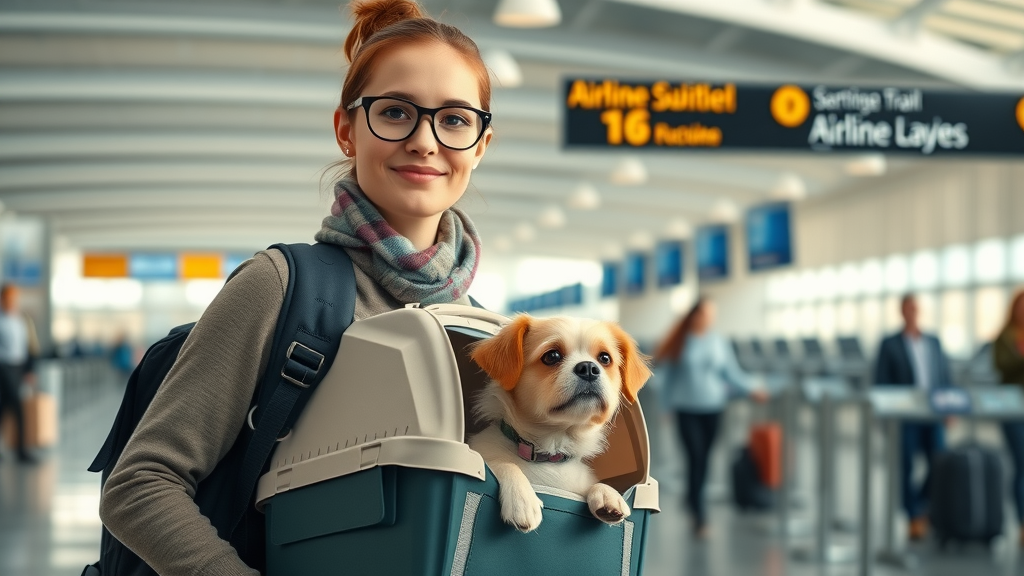
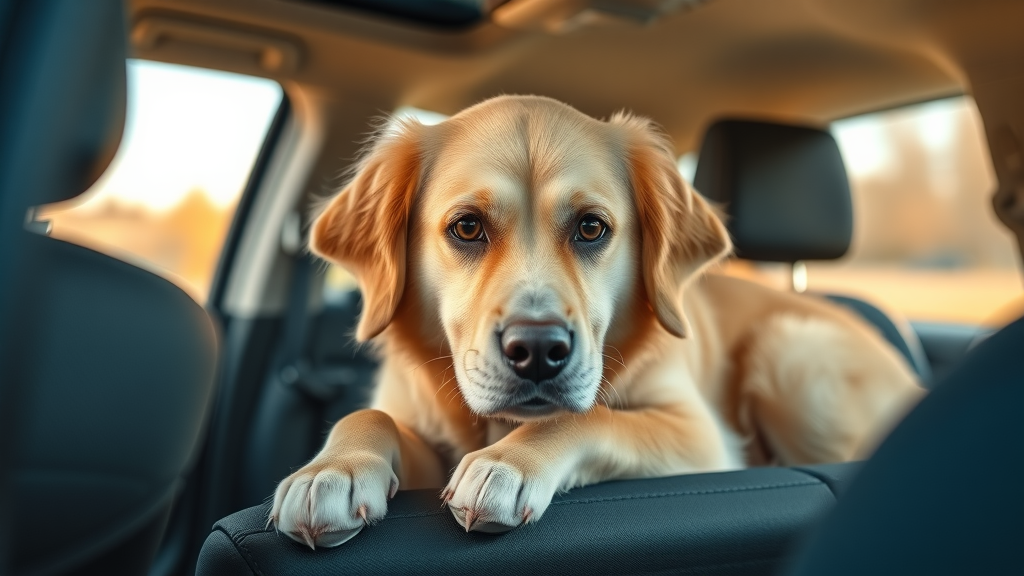
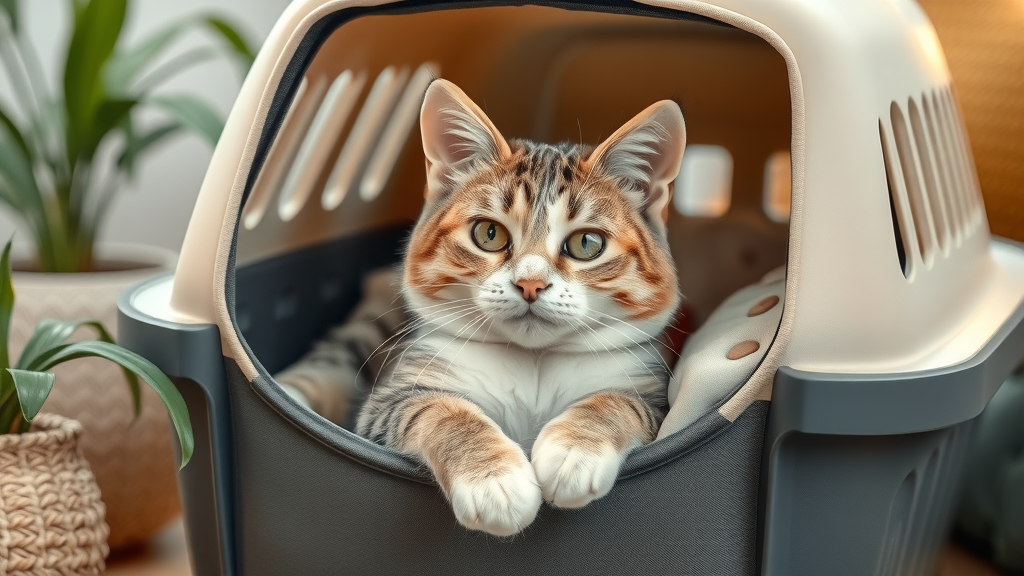
Write A Comment